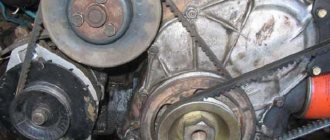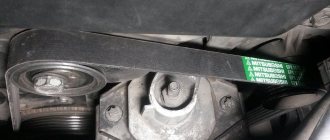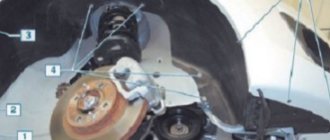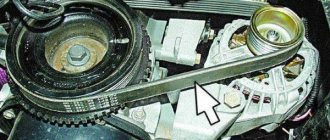1200 rub. for the photo report
We pay for photo reports on car repairs. Earnings from 10,000 rubles/month.
Write:
During the operation of the car, the owner is faced with many problems, including an unpleasant situation with the alternator belt. He begins, seemingly for no reason, to “whistle”, and it is not so easy to immediately guess why this is happening. In our case, we are not talking about a worn or old belt. Everything is clear here - I replaced everything. No, everything is much more interesting, and, as in an exciting English detective story, we will look for a cause-and-effect relationship.
Inspect the belt and look for reasons why the belt whistles.
So, why does the new alternator belt “whistle”? As it turns out, there are several reasons for this and they are all presented below.
Briefly about the hanging belt
Belt drive is the most common method of transmitting rotation to the generator rotor. The method has been used for a long time and differs from others in its simplicity: only two pulleys on shafts that are connected by a belt.
The belt itself is responsible for a lot. It is he who is responsible for transmitting rotation from pulley to pulley. You should be aware that one part of the belt is tighter than the other . It is the difference between these tensions that determines the traction force and its coefficient.
The belt provides precise transmission and is quiet in operation. High-quality products are able to withstand long-term loads, smooth out shocks and jerks. They are compact, take up little space, but simultaneously operate several important components of the car: generator, pump, air conditioning compressor and power steering pump.
The generator rotor must rotate constantly. This is facilitated by the belt connection to the crankshaft. The pulleys, which are screwed onto the generator and crankshaft shafts, are connected by a belt, which must be flexible.
The “whistle” of the belt is similar to a disgusting clang. It is caused by the belt slipping. The sound of such a whistle is unpleasant and can be heard at a great distance. Of course, you should not drive in such a situation.
Belt whistling and its causes
Some motorists refer to the fact that the belt was allegedly of poor quality and replace it, but everything starts all over again. For this reason, in order not to waste valuable time and extra money, it is recommended to inspect the entire belt drive. Analyzing the conditions under which the whistle occurs is the most useful judgment a car owner can make.
The check comes down to the following steps:
- the integrity of the belt is checked (we agree with the version that today even new products can be of poor quality);
- the degree of tension is checked (as is known, belt squeaks often occur due to weak tension);
- the cleanliness of the shaft is checked (another reason for the “whistle”, which is described in detail below);
- the line of two pulleys is checked for displacement.
Let's sum it up
As we have seen, adjusting the tension of the belt drive in the Lada Kalina is possible even for an inexperienced car owner. The main thing is to remember to timely and periodically check the condition of this element. If you neglect this, you can personally provoke breakdowns that are more expensive in terms of repair. Carry out the tension correctly, based on the aspects given in this material, and then the alternator belt will serve you for a long time. At the first sign of wear on the belt drive, take measures to replace it. Operation of a worn-out component is fraught with its sudden breakage.
Five main reasons why a generator whistles
Below is a list of the most common causes of alternator belt whistling:
- Cleanliness of car parts is an important rule that the owner of the vehicle must observe. Oil that accidentally gets on the belt or shaft causes an unpleasant squeak. This happens due to the fact that the belt loses its former adhesion to the surface of the shaft and slips.
The provisions listed above are the main ones. But this does not mean that there cannot be other reasons. The most important thing is to respond to the problem in a timely manner and take immediate measures to eliminate it, then you will forget how the generator belt whistles.
You can recognize a certain type of malfunction in a vehicle by its characteristic sound. The most common problem, which even a driver without experience can identify, is the whistling of the alternator belt. Many people believe that if an unpleasant whistle occurs, it is necessary to immediately replace the belt. However, there are a large number of other reasons why the belt whistles and it is not at all necessary to replace it. Therefore, before replacing the belt, the driver must conduct diagnostics that will allow him to find the exact cause of the squeak.
RENO LOGAN
Reno Logan also has its own specific design features of the generator drive, which may cause a whistle to appear
The first of them is the use of 6-groove pulleys, while the belt itself is 5-groove, and here when replacing it is very important to put it on correctly, otherwise the line of its position will be violated, in fact, a skew will appear, which is why a whistle will appear. At the same time, with different numbers of attachments, the drive is installed in its own way
On models equipped with power steering, the outer groove of the pulleys should remain unclaimed (the belt should be moved closer to the engine and components).
But in versions with power steering and air conditioning, on the contrary, the rivulets on the inside of the pulleys are not used. The second feature is the absence of an automatic tensioning mechanism on models equipped with power steering. Therefore, on these Logans, when a whistle occurs, first of all, you should check the belt tension and, if necessary, tighten it.
Lada Priora has no specific reasons for the whistling of the generator drive, they are all common, but there are design features that are important to consider. This car not only does not have an automatic belt tensioning mechanism, but also to adjust the tension you need a special key, which turns the eccentric element, due to which tension occurs
If we take earlier versions of the VAZ, for example, 2114 or 2110, then their belt drives only the generator, so even the tensioner is not used (tensioning is done by displacing the generator itself). There are no specific reasons for whistling in these cars, they are all standard - incorrect tension, dirt, bearings, etc.
But on even earlier models - 2107 or 2108, the use of a V-belt alternator can be considered a feature. This type of drive is considered more reliable, but in terms of flexibility it is much inferior to a poly-wedge (multi-strand) drive, which is why it is not used on modern cars. On these cars there is one specific reason for the appearance of a whistle - wear on the working surfaces of the pulleys. As a result, the belt sinks very deeply into the groove, which causes it to jam, accompanied by a squeal. Moreover, replacing the flexible element solves the problem for a short time (until it wears in). To completely eliminate the cause of the whistle, you need to change the pulleys.
What is a generator belt?
The generator belt is installed to transmit torque to the generator rotor from the crankshaft. Due to this, electricity is generated, which is subsequently distributed among all consumers and for recharging the battery. To operate the belt, pulleys are used, and it is on them that the belt is put on to connect to the crankshaft.
In addition, a feature of the belt is its quiet operation. High-quality products can withstand heavy loads for a long time, while constantly smoothing out jerks and shocks. The belt sizes are small. For this reason, they do not take up much space. However, this part simultaneously sets in motion important structural components in the car, including the power steering pump, water pump, air conditioning and the generator itself.
Noise when turning on the car air conditioner
Let’s say right away that the climate system is not purely automotive equipment, therefore such equipment is usually not repaired in service centers and service stations. You can be sure that in the event of a breakdown, restoring the functionality of your car air conditioner will cost you a pretty penny, and the chances of doing it on your own are extremely low, even if you consider yourself a car guru. That is why it is so important, when the first signs of problems appear, to be aware of what caused them in order to make a prompt decision.
Of course, if the air conditioner in the car is noisier than usual, this should be taken as symptoms that indicate problems earlier than others (although in some cases they may not be evidence of problems). The first thing you need to pay attention to in such situations is where it comes from. This can be easy to determine, especially with the hood raised. Most often, strange sounds are heard from the compressor, which clearly indicates the place where problems should be looked for.
Localizing the fault greatly simplifies the search for the immediate cause of the noise. But this does not always happen: sometimes the breakdowns are partial. The compressor can continue to operate without making noise, and, nevertheless, not create the required freon pressure in the system. There are often cases when the device functions normally, but the seal is broken, and this affects the cooling efficiency. Finally, a common failure is the failure of the bypass valve. In any case, identifying the location where the strange noise is coming from clearly indicates where to look for trouble.
Why does the driver hear a whistle?
When the power unit operates in a car, the belt, along with other drive belts, experiences maximum loads.
Most of the drive belts installed in the machine have a wedge shape, which provides a greater frictional force in the place where the part contacts the pulleys. Such elements even have appropriate names - V-belts.
These same products, but having several paths at once, called streams, are called polywedges.
Generator belts can be with or without teeth. It is generally accepted that products with teeth have a longer service life, since they wear out and slip less often.
So why is there a whistle? In 95% of situations, the manifestation of an unpleasant whistling sound occurs due to the friction of the belt on the pulley if slippage occurs. It turns out that when the belt is unable to turn the pulley, then it slips. This action is accompanied by a sound resembling a whistle.
The motorist should not look for the cause of the sound, but for faults that cause the belt to slip.
There may be several of them:
- Weak and, conversely, very tight tension of the generator belt. Over time, the belt may stretch. The main reason for this is wear and tear of the lower part of the part. The car owner will only need to tighten the connection point. However, it is important to remember not to tighten it too much. In the longest section, the blade should have a stroke in the range of 8 - 10 millimeters. A belt that is too tight can also cause a squealing noise. It is no secret that extremely tight tension does not allow the pulleys to rotate normally. This situation often occurs in winter. The squeak disappears from the moment the engine reaches operating temperature and the belt takes its previous shape.
- Poor quality or temporary wear of the belt. Often, the material used in the production of the belt itself is not the same material applied to the outside of the product from Chinese manufacturers. When the top layer wears, the belt makes a squeaking sound. If the wear is too great, then even the next tension will not help eliminate the problem with the belt whistling. When cracks appear on the product or traces of major destruction can be visually detected, the problem can be corrected by replacement. There is no point in delaying this issue, since such a belt can break at any time.
- Contact with the pulley or belt of technical fluid used in the operation of the machine, for example, oil, washer fluid and even plain water. Problems with whistling appear most often due to contact with engine oil. The belt loses its previous grip and slips with the appearance of a characteristic sound.
- Malfunction of the tension roller or generator bearing. A technical problem with the bearing can cause an unpleasant sound emitted by the hanging belt. The owner of the car will only need to replace the bearing. This structural unit also has special tension rollers. This part is a type of bearing that can begin to seize over time. Because of this problem, the movement of the belt drive is disrupted, the belt rubs heavily against the pulley. In this situation, the belt will show signs of severe wear. The car owner must inspect the mechanism, remove the belt and check the play of the rollers.
- Axle mismatch between pulleys. The appearance of a nasty whistle may be due to misalignment of the line between the two pulleys. The pulleys must be positioned strictly on the same axis, and even a slight slope can cause a whistle.
There are several pulleys in a car. The first is located on the crankshaft, and the second on the generator. With constant use of the car, the pulleys wear out. A small pulley is installed on the generator; on the crankshaft, on the contrary, the largest one is installed. Most of the load will go on the small pulley. Some automakers make a small alternator pulley from not the most durable materials. Therefore, wear of the teeth on this part is a matter of time. In addition, situations often occur when damage occurs on the track itself, for example, after an impact.
In any case, the car owner will need diagnostics and replacement of damaged parts.
You will also be interested in:
Step-by-step instructions for eliminating the defect
If noise appears when starting the engine after replacing an element, then there are several ways to eliminate the problem. Each of them will be considered in turn. If the quality of the strap is too low and it is already worn out, then it will need to be replaced; there are no other options. We will not consider this process, since it is individual for each car.
Use the search on our website to find step-by-step instructions for replacing an element for your car. You will find more information about this here. Next, we will look at options for eliminating the problem without removing the strap.
Lubricating the strap
Lubricating the element is one of the solutions to the problem if, after replacing the component, noise appears when starting the engine.
To lubricate the component, you need to purchase a special aerosol, which is sold in any store. In addition, universal WD-40 can be used for these purposes. Naturally, this solution is temporary, but it will only take a few minutes, after which the noise will no longer bother you.
- Take your aerosol and open the hood of your car.
- Remove the protective cover of the mechanism, which is secured with bolts, using the appropriate wrench.
- Be careful as you will need to start the car for it to work. This will make lubrication more effective. After starting the engine, you will need to aim to ensure that the liquid hits the inner parts of the strap, that is, the teeth. Lubricate the element for five to ten seconds so that the liquid is guaranteed to reach all the teeth.
- Stop the engine and replace the mechanism cover. Enjoy the results.
Repairing the leak
If the reason why the whistle appears is the ingress of engine oil or other liquid, then it is necessary to eliminate all possible leaks:
- If engine oil gets in, first check the cylinder head for leaks. If the head even slightly moves away from the block itself and oil comes out, then you will need to dismantle the head and grind it. You will also need to change the gasket, since in practice it is the cause of oil leakage.
- If antifreeze is leaking, then also check the contact point between the cylinder head and the block itself. It is possible that coolant enters the engine due to a broken gasket. Also check all cooling system pipes to ensure they are not leaking or leaking.
- If the problem is “brake fluid” or, for example, air conditioning fluid, then you need to identify all possible leaks. Observe the timing mechanism with the engine running. You may be able to identify the problem without removing the belt.
Why does the belt whistle when cold?
The problem of whistling when cold can have several varieties. A squeak or whistle does not appear when the engine starts, but after a couple of minutes. This problem is easily diagnosed, since after the engine reaches operating temperature, the sound disappears.
The reason for the non-standard behavior of the belt is also hidden in its slippage. The torque transmitted from the crankshaft is not sufficient to spin the pulley. There are several reasons for this problem:
- Inaccurate selection of bearing lubricant for the generator. Due to the compaction of the lubricating fluid consistency at low temperatures outside, the generator pulley is not able to function as usual until the machine’s power unit warms up. At engine operating temperature, the lubricant will defrost and the unpleasant sound will disappear. The solution to the problem will be for the car owner to purchase a lubricant option that is more resistant to temperature changes outside the window.
- Weak tension. This situation is identical to the previous one. Until the engine reaches the required operating temperature, due to low tension, the belt is not able to perform its functions at the required speed and will slip.
How to remove the whistling of the alternator belt
To eliminate belt whistling, you first need to determine the reasons that cause the alternator belt to slip.
The slippage problem is accompanied by an unpleasant whistle, and it must be eliminated in this order:
- The engine is switched off, the hood is opened and locked.
- The belt is carefully inspected, and there is no need to remove it from the pulleys. The surface of the part must be free of tears, loose threads and other damage. If signs of wear are detected, the part should be replaced.
- Both sides of the alternator belt should not be wet, with traces of dirt, or signs of ingress of any technical fluids used in the vehicle. It's the same with pulleys.
- Check the tension value of the part, because most often the whistle from under the hood is due to a loose belt. You can find information about the required alternator belt tension parameter for any car model in the included factory instructions or on the Internet.
If these actions are not successful, a whistle is still heard from under the hood, you can start the engine and, in good lighting, visually check the alignment of the pulleys.
A clear sign of misalignment is the moment when the poly V-belt jumps between tracks and slides off the pulley.
Attention should also be paid to nonlinearity during pulley rotation. If one of these parts draws a figure eight when rotating, over time it will either reset or tear the alternator belt. This behavior is typical for pulleys with a rubber damper. This material quickly loses its former elasticity and does not fulfill its duties.
When, even after all the above steps, the problem does not disappear, then you should look for a solution either in the belt itself or in the structural elements driven by it. The reason may be hidden from the car owner in thickened lubricant of the bearings or their failure.
You can eliminate the nasty sound of the alternator belt for a while using special auto chemicals. For example, an air conditioner tensioner will help eliminate the problem for a short time. Auto chemicals will not help completely eradicate whistling, but the driver will ensure silence for a while.
Sometimes car problems can be determined by hearing. One of the most common troubles is the whistling of the alternator belt. In some situations, such a characteristic sound is one of the symptoms of malfunction of the entire unit. Today, the generator belt is one of the few ways to transmit crankshaft rotation to the generator shaft and generate electrical energy. Alternator belt wear and problems can cause your vehicle to stop running at the wrong time.
What is a generator belt, its purpose and features
The alternator belt can be classified as the most vulnerable element in a car's design. The biggest consequences are caused not even by breakdowns of the main components, but by neglect of control over lubricants, technical substances, care of filters and boots, and the generator belt.
Today, the principle of operation of the alternator belt is considered one of the most reliable and simplest ways to connect the operation of the crankshaft and the generator. This is due to the simple technical design and low production costs.
The elastic band, if broken or worn excessively, can immobilize the vehicle. To avoid such a problem, it is better not to neglect timely inspection and replacement of the alternator belt.
When the engine is running, a very large load is placed on the belt. Therefore, a good part must meet all quality indicators: geometric characteristics, material of manufacture, certification.
For manufacturing, high-strength rubber (or other elastic material) is used, which is reinforced with polymer threads and lined from the inside with a multilayer fabric base. Thanks to its complex structure, the belt provides excellent adhesion to pulleys and rollers without losing elasticity.
To ensure better grip, the belts have different shapes:
- Wedges. They connect one or two elements and are intended for reverse bending. In cross-section they have a trapezoidal shape and can withstand very heavy loads.
- Serrated. In some cases, such an alternator belt can replace a timing belt. Has excellent accuracy in transmitting torque. The structure has transverse slots.
- Polycline. Visually they differ in the presence of longitudinal grooves and a significantly larger width.
Chemistry or noise?
Whistling is not only artistic. Very often he is simply annoying. Car enthusiasts have always had a negative attitude towards such creativity. But, instead of replacing the worn-out belt and getting rid of the noise in this way, they began to come up with folk wisdom on how to extend its life.
Among the most popular life extension measures was treating the belt with rosin dissolved in alcohol. This made the belt more elastic, less susceptible to cracks, and slippage was reduced. To some extent, this treatment made it possible to increase the service life of the belt.
Hi-Gear also offers a similar method for extending service life. Her Belt Dressing aerosol has a fairly average cost (around 350 rubles), but allows you to almost double the service life of the belt. This increases elasticity and improves appearance. It is possible to use the spray for belts of various systems: serpentine and wedge-shaped. It cannot be said that this remedy is a full guarantee that there will be no more whistling. If the spray is used, but the whistle remains, then the problem is not in the belt, but in the bearing.
Diagnosis of alternator belt problem
The main sign that something is wrong with the alternator belt is a specific whistle. Most often, it can be detected at a time of increased load on the vehicle’s electrical systems.
There is nothing critical or catastrophic about the fact that the belt began to whistle. However, the appearance of uncharacteristic sounds cannot be ignored. For example, if the whistle increases with increasing speed, the belt is loose and the generator itself is working worse than it should and is not fully charging.
It is much worse if the whistle does not disappear when the electrical load changes. Constant noise may indicate the need for urgent repairs or replacement. To finally verify this, the belt must be inspected:
- Visually, the tape should be intact, without scuffs or cracks.
- There should be no traces of grease or technical fluids on the belt and pulleys.
- The tension level should be normal.
- The line of the two pulleys is located without displacement.
Reviews
This is not the first time I come to West Auto on Gogol 51. The guys are all friendly and sociable, masters of their craft. I would like to highlight the master Andrey and the manager Pavel. The guys solved the problem of my car quickly and efficiently. I recommend West Auto to everyone! More details
I really liked the service at the Zapad Auto service and the culture of communication with clients, i.e. with me. Thank you so much! More details
Passing through Ryazan. I am very glad that I came to you. They fixed it quickly. Thank you. More details
Low elasticity, contamination and liquid ingress
For the alternator belt to operate correctly and as efficiently as possible, it must be absolutely clean. The presence of dirt balls puts a lot of stress on the belt when it prevents it from moving evenly and maintaining tension. If during inspection a build-up of dirt and dust was found, you can risk cleaning the tape yourself. Perhaps using gasoline or additional means. If it was not possible to clean the belt, the consumable will have to be replaced.
A similar scheme operates if liquid is detected on the belt. Most often, to continue proper operation, it is enough to remove drops of moisture or technical substances from the surface of the belt.
The opposite situation occurs due to constant or regular exposure to car shampoos, water, detergents and chemicals. Constantly in contact with the polymer structure of the belt, they dry out and contribute to cracking of its surface. To protect the operating process of the car, the alternator belt can be treated with a protective liquid. Its task is to maintain the elastic properties of the material and improve its performance.
It is best to resort to this measure for preventive purposes in order to increase the resource of the element by 1.5–2 times. Such products are produced in the form of an aerosol.
Uneven pulley line
The next reason for belt whistling is misalignment of the pulleys. For proper operation, the generator pulleys and engine shafts must be in line.
To diagnose the problem, you need to use a ruler to measure the level of the pulleys. Elements are considered coaxial only if there are no gaps between the surface of the ruler and the pulleys. This problem can be corrected by eliminating the deformation of the fastening of the hinged part using straightening or simply replacing the pulley.
If it is not possible to check the alignment due to a non-standard front surface or fastening, then the pulleys must be unscrewed. It is necessary to stretch a thread or string between the flanges. Next, we apply a ruler to the flange and, if the elements are parallel, the two pulleys are on the same axis.
Tension problems, belt replacement
Car enthusiasts say that in 90% of cases, the cause of an uncharacteristic whistle is insufficient or excessive belt tension. A special bracket is responsible for the degree of tension, and you can find out the norm for each specific car in the technical passport of the vehicle.
Weak tension on the alternator belt reduces the efficiency of the alternator by an order of magnitude, causing it to not generate the required current. In addition, this is accompanied by rapid wear of the tape. On the other hand, too much tension increases the risk of bearing failure.
To tighten the generator belt, you need to unscrew the nut that connects the generator and the bracket. The bottom nut needs to be loosened a few turns. You can control and change the belt tension by slightly moving the generator away from the cylinder block. After all the manipulations, the nuts are tightened and a check is carried out - before starting the engine, several energy consumers are turned on (headlights or stove). If the work is done correctly, the whistle will disappear.
To replace the belt, you need to repeat the same steps, only you need to move the generating device until the belt is removed from the pulleys. After replacement, you need to let the engine run for a few minutes so that the belt fits correctly.
Understanding the device
To understand why the timing belt whistles after replacing it or after a long period of use, when starting the engine or simply when it is running, you need to understand the device. The issue of noise is pressing for many domestic motorists.
Removing the timing belt
The timing belt is a device that ensures the admission of the combustible mixture into the engine cylinders and the further removal of exhaust gases from the combustion chamber. This mechanism, as mentioned above, is one of the most complex motor devices, since it must not only open and close the valves. The timing belt must be done in a specially designated period of time. In any case, the operation of the unit must be synchronized with the functioning of the ignition and injection system.
When the driver needs to increase the speed, he presses the gas pedal, thus ensuring that more gasoline and fuel mixture enters the engine. This device consists of several groups of parts. Engine valves are designed to open and close intake and exhaust ports. The engine drives ensure rotation of the shafts at a specific speed. And the purpose of the distribution pulleys is to control the valves.
A head is installed above the cylinder block of the internal combustion engine, on which you can see the distribution pulley, valves and pusher devices. The timing pulley disk is located outside the cylinder head. To prevent engine fluid from leaking out from under the valve cover, a special oil seal is installed on the camshaft. The timing belt, which suddenly whistles after replacement, is put on the camshaft pulley disk and begins to function when the crank pulley gears rotate.
To ensure that the timing belt is always well tensioned, tension rollers are used. The strap itself ensures the operation of the device, and the drive strap ensures the operation of additional equipment. This is what the gas distribution mechanism system looks like in brief. But why did the noise appear when the engine was cold when starting? And why does the timing belt whistle after replacement? How can this noise be related to the operation of the engine?
Belt wear and other reasons
In addition to the most common reasons, unpleasant sounds from under the hood can also be caused by problems with bearings, couplings or pulleys. Replacing the problematic part and timely technical inspection in the future will help correct the situation.
If you miss a scheduled replacement of the alternator belt, the risk of stalling in the middle of the road will increase every day. The belt may lose its elastic properties, crack or break. This process will be accelerated by poor quality tape.
To avoid problems with the drive belt and effectively eliminate the consequences of problems, it is better to find out more about the problem in advance. Visual videos will help with this:
Tensioner pulley design
Thus, on most modern cars the roller is of the following design:
- ball bearing inside
- plastic cover with a working surface for the belt on top
- landing sleeve inside the roller
Rice. 3 Design of the tensioner roller There are eccentric rollers, the adjustment of which is carried out by shifting the axis relative to the mounting bolt, and conventional ones. In the second option, the roller is mounted motionlessly on the tensioner bracket, and for adjustments the bracket itself is shifted relative to the internal combustion engine shaft.
Rice. 4 Eccentric tensioner pulley
Some cars use self-adjusting spring brackets, in which the number of turns and the diameter of the spring wire are designed for a specific force at the factory.
Rice. 5 Self-adjusting spring tensioner using the example of a Mercedes Sprinter
Since there is a bearing inside the structure, the roller is replaced when any of these parts (bearing race or plastic lining) wears out. In addition, when replacing a belt, it is also recommended to install a new roller/bearing set on the tensioner.
An example of the layout of two generators with one tensioner pulley for high-quality car audio
Rice. 6 An example of the layout of two generators with one tensioner pulley for high-quality car audio
To ensure its recharging, the best option is to duplicate the generator, for which a second pulley is mounted on the crankshaft of the internal combustion engine. In this case, you have to service two rollers and a belt of the tension system.











